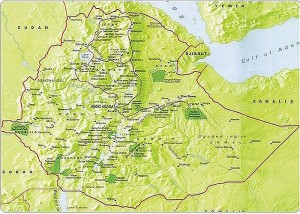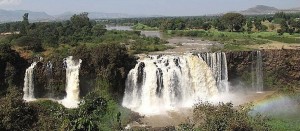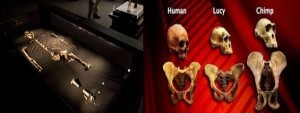
The term “Ethiopia”, which means “burnt face” in Greek, was first used by Homer and Herodotus to refer to the place between south of Egypt and Indian Ocean because the area was inhabited by people having that color.
Ancient Egyptians used to call the place south of their country as “Land of the Cush”. Prophet Moses used the term to refer to that place because he grew up in Egypt learning their language and culture.
The Seventy Scholars, who lived in the second century B.C. and translated the Holy Bible from Hebrew into Greek, used the term “Ethiopia” to refer to the place that Moses called “Cush”. This term has been mentioned more than 40 times in the Holy Bible. Currently the term Ethiopia is used to refer to the East African country which has an area of about 1,119,683 Km2.
Ethiopia is a land with a very unique culture and heritage. With a history going back thousands of years, it is one of the oldest nations in the world. Ethiopia offers international tourists an unrivalled choice. A country with one of the richest histories on the African continent, is a land of natural contrasts, ranging from the peaks of the rugged Simien Mountains to the depths of the Danakil Depression, which at 120 meters below sea level, is one of the lowest points on earth. Ethiopia is blessed with an abundance of natural beauty, offering an astonishing variety of landscapes, including Afro-Alpine highlands soaring to around 4,300 meters, moors and mountains, deep gorges, the largest cave in Africa (Sof Omar), the Great Rift Valley, tropical forests, white-water rivers, savannah land, giant waterfalls and volcanic hot springs. Although situated close to the equator, the country largely has a climate tempered by altitude, which means that most of its regions enjoy an idyllic spring-like climate throughout the year. In its considerably vast area (1.14 million sq.kms), Ethiopia has tourist attractions that will appeal to a wide range of interests. The combination of attractions is rare in a single country and includes a wealth of historical, cultural, archaeological and anthropological sites, as well as numerous areas rich in natural gifts. Ethiopia is the land of the Queen of Sheba, home of the Ark of the Covenant, the birth place of coffee and ‘Lucy’- the world’s oldest known almost-complete hominid skeleton, more than three million years old.
A country with Old history and Great Civilization

The world looks different when viewed from a mountain plateau at 2,500 meters above sea level: the landscape appears almost upside-down. Since ancient times, this land has been known as a place of mysterious kingdoms and fabulous wealth, as the country of Punt, who, according to the ancient Egyptians, was the progenitor of their gods.
Do you know that Ethiopia is mentioned in the Bible more than 38 times by both Old and New Testaments? Ethiopia has a proud and long history extending to the known beginnings of humankind. The Historic Route, covers, among others, the ancient town of Axum, the capital of the far reaching Axumite Kingdom, which dominated the vital crossroads of Africa and Asia for almost a thousand years, with its amazing carved obelisks, Christian festivals and relics, including the Ark of the Covenant, Lalibela, with its 11th century remarkable rock hewn churches that the world have ever seen until Gondar, the capital of Ethiopia during 1632-1667,with its castles and palaces; Negash, one of the earliest holy Muslim centers from the Prophet Muhammad Era with the Negash Amedin Mesgid; the walled Muslim city of Harar and Lega Oda, near Dire Dawa where one can see cave paintings considered to be thousands of years old. All these would be enough to make Ethiopia a fascinating place to visit and travel through, but Ethiopia has so much more to offer.
A land of Beauty

Known locally as Tis Isat – ‘Smoke of Fire’– the Blue Nile Falls is the most dramatic spectacle on Blue Nile River. Rivaling the attractions of the Blue Nile falls is Lake Tana, source of the Blue Nile, which is the largest lake with 37 islands scattered about on the 3,000 sq. km surface of Ethiopia’s largest body of water. Some 20 of these islands shelter churches and monasteries of significant historical and cultural interest dating back to the 14th century. The Great Rift Valley lakes, many with national parks, are home to a wealth of bird and animal life offering a wide opportunity for bird-watching and camping along the chains of national parks. The high, rugged Siemen Mountains in the north are one of the major mountain massifs in Africa. The region includes many summits above 4,000m and culminates in the highest point in Ethiopia. Ras Dashen, at 4,543m, is the fourth highest mountain in Africa, home to the Walia Ibex, a unique indigenous mammal.
The Bale Mountains, in the south east are also home to some unique wild life and rich flora, and are ideal for trekking; whilst some of Ethiopia’s fast flowing rivers are becoming famous for white-water rafting.
A land of Culture, Tradition and Home of Diverse people

Ethiopia has culture and traditions way back over 3000 years. With its over 80 different ethnic groups, with their own language, culture and traditions. The strong religious setting, celebrations and festivals play an important part in every ones daily life. Church ceremonies are major feature of Ethiopian life. The events are impressive and unique. The Ethiopian Orthodox Church has its own head, follows its own customs and is extremely proud of its fourth century origins. “Are you not like the Ethiopians to me, O people of Israel?” (Amos 9:7?)
Islamic tradition is also strong and offers colorful contrast, particularly in the eastern and south eastern parts of the country. Historical records testify that there were Ethiopian Muslims during the lifetime of Prophet Mohammed. History has it that when the early followers of the Prophet Mohammed were denied the right to pursue their religion, and were harshly persecuted by the mercantile rulers of Makah. He pointed to the kingdom and said: “A country where in no one is wronged: a land of righteousness. Depart there and remain until it pleased the lord to open your way before you.” Prophet Mohammed. This rich religious history is brought to life in the romantic walled city of Harar, considered by many Muslims to be the fourth holy city following Mecca, Medina and Jerusalem.
Ethiopia is a mosaic of people with more than 80 nations and nationalities. The Cushitic, the Semitic, the Nilotic and the Omotic language groups live in harmony side by side. The lower Omo is the home of Omotic, Cushitic and Nilotic linguistic group with their untouched culture. It is situated following the vast Omo River, the sole contributor to the East Africa’s fourth largest lake, Lake Turkana, in Kenya. Its landscape is diverse that boarders the Mago and Omo rivers. The Omo Valley is unique in that four of Africa’s major linguistic groups including the, endemic, Omotic languages are represented within one relatively small area. To anthropologists; the Omo Valley is not far from being the Living Museum. The area is home to many diverse and fascinating peoples and cultures.
Folk culture is also an important element of today’s Ethiopia. Ethiopian cuisine is unique by way of ceremony, flavor, color and presentation. The traditional restaurants and cultural centers around the country provide a mix of presentation with warm folk music and dances, traditional cuisine and an opportunity to experience a unique Ethiopian coffee ceremony.
A Land of Discovery

Ethiopia is known the earliest the home of human race. A skeleton of an older human ancestor Australopithecus Afarensis was discovered in 1974 in the Afar region. Anthropologists have established that the skeleton covering 40% of the human body had belongs to a twenty years old female that lived 3.5 million years ago. Registered by the UNESCO as a world heritage, the site of the discovery called “Hadar” situated 160 kilometers northeast of Addis Ababa, the capital city of the country.
The skeleton is popularly known as Lucy or Dinkinesh. The Discovery has completed the missing link between apes and men paving the way for the search to human origins.
In addition, the earliest known hominid, 4.4 million years old Ardipithecus Ramidus was discovered in the Middle Awash in 1992. The recent discoveries include Australopithecus Garhi, 2.5 million years old hominid.
Garhi means “surprise” in the Afar language- a language spoken in the internationally acclaimed archaeological site. Discovered by an international team led by Ethiopian Anthropologist Berhane Asfaw in the Middle Awash, Gahri is said to be a surprising hominid. Palaeontologist Tim White of the University of California at Berkeley was also the co-leader of the team. The species discovered by the team is descended from Australopithecus Afarensis and is a candidate ancestor for the early homo.
Bones from antelopes and horse were found 278 meters from the site of Garhi skull fragments at the same layer of sediment. The bones show unmistakable gashes left by stone tools; the animals were butchered, the meat cut away and the bones hammered open to extract stuff. This is by far the earliest proof of tool based butchery and may well provide the evolutionary theory that led to big brained humans.
For the above mentioned and other reasons, many people visit Ethiopia or hope to do so one day, because of the remarkable manner in which ancient historical traditions have been presented. And, indeed, the ceremonies and rituals of the Ethiopian Orthodox Church open a window on the authentic world of Old Testament. In no other country it is possible to find yourself so dramatically transported back in time or to participate with such freedom in the sacred rituals of an archaic faith.
And yet more to be discovered by you! A very warm welcome is waiting for you in the land beyond all your imaginations.
